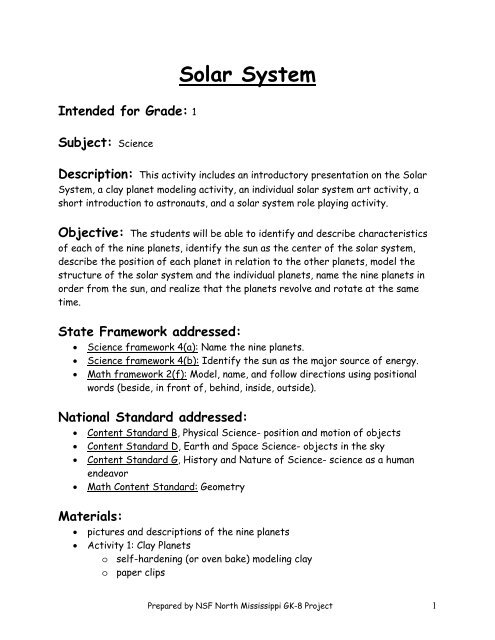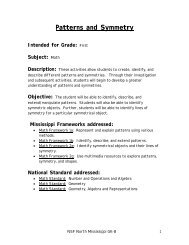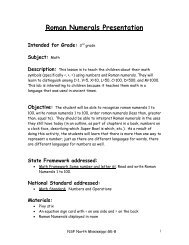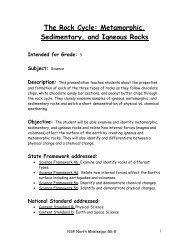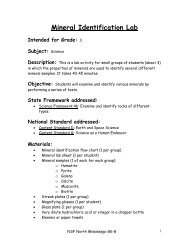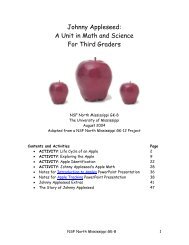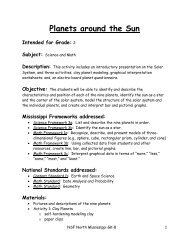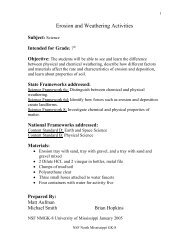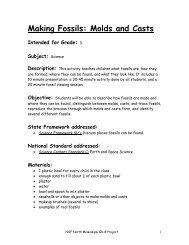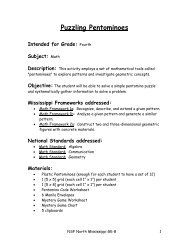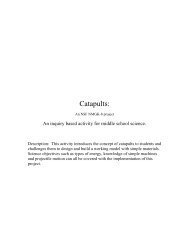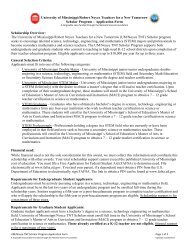GK-8 Project Submission Form - The Center for Mathematics and ...
GK-8 Project Submission Form - The Center for Mathematics and ...
GK-8 Project Submission Form - The Center for Mathematics and ...
- No tags were found...
Create successful ePaper yourself
Turn your PDF publications into a flip-book with our unique Google optimized e-Paper software.
Intended <strong>for</strong> Grade: 1Solar SystemSubject: ScienceDescription: This activity includes an introductory presentation on the SolarSystem, a clay planet modeling activity, an individual solar system art activity, ashort introduction to astronauts, <strong>and</strong> a solar system role playing activity.Objective: <strong>The</strong> students will be able to identify <strong>and</strong> describe characteristicsof each of the nine planets, identify the sun as the center of the solar system,describe the position of each planet in relation to the other planets, model thestructure of the solar system <strong>and</strong> the individual planets, name the nine planets inorder from the sun, <strong>and</strong> realize that the planets revolve <strong>and</strong> rotate at the sametime.State Framework addressed:• Science framework 4(a): Name the nine planets.• Science framework 4(b): Identify the sun as the major source of energy.• Math framework 2(f): Model, name, <strong>and</strong> follow directions using positionalwords (beside, in front of, behind, inside, outside).National St<strong>and</strong>ard addressed:• Content St<strong>and</strong>ard B, Physical Science- position <strong>and</strong> motion of objects• Content St<strong>and</strong>ard D, Earth <strong>and</strong> Space Science- objects in the sky• Content St<strong>and</strong>ard G, History <strong>and</strong> Nature of Science- science as a humanendeavor• Math Content St<strong>and</strong>ard: GeometryMaterials:• pictures <strong>and</strong> descriptions of the nine planets• Activity 1: Clay Planetso self-hardening (or oven bake) modeling clayo paper clipsPrepared by NSF North Mississippi <strong>GK</strong>-8 <strong>Project</strong> 1
o string• Activity 2: Solar System Pictureo paint or markerso black construction papero gel pens or metallic markerso glow in the dark starso glue• Activity 3: Solar System Role Playo Yarno Sidewalk chalko Sun <strong>and</strong> planet pictures (necklaces)• astronaut foodBackground: <strong>The</strong> scientists that study the solar system are calledastronomers. <strong>The</strong>y study the universe, including the sun, moon, planets, stars, <strong>and</strong>galaxies. <strong>The</strong>y also apply their knowledge to solve problems in navigation, spaceflight, <strong>and</strong> satellite communications, <strong>and</strong> to develop the instrumentation <strong>and</strong>techniques used to observe <strong>and</strong> collect astronomical data. Astronauts are thescientists that actually fly into outer space. During their space missions, they usethe instruments <strong>and</strong> techniques designed by the astronomers to collect in<strong>for</strong>mationabout our solar system.Our SOLAR SYSTEM is made up of one star (the Sun), nine planets, more than 130moons, <strong>and</strong> a bunch of comets, asteroids <strong>and</strong> other space rocks. <strong>The</strong> nine planetsare Mercury, Venus, Earth, Mars, Jupiter, Saturn, Uranus, Neptune <strong>and</strong> Pluto.Mercury is closest to our Sun. Pluto is the farthest. Remember the order of theplanets like this: My Very Educated Mother Just Served Us Nine Pizzas.Planets, asteroids <strong>and</strong> comets revolve around the Sun. <strong>The</strong>y travel around in ourSun in a flattened circle called an ellipse. It takes the Earth one year to gocompletely around the Sun, or one year to complete a revolution. Mercury goesaround the Sun in only 88 days. It takes Pluto 248 years to make one trip aroundthe Sun.As the earth revolves around the sun, it also rotates around its own axis. <strong>The</strong>earth completes one rotation per day. This rotation is why we experience day <strong>and</strong>night- during part of the rotation, our portion of the earth is facing away from thesun, so it is dark outside! <strong>The</strong> earth completes 365 rotations over the course ofone revolution.Prepared by NSF North Mississippi <strong>GK</strong>-8 <strong>Project</strong> 2
Moons orbit planets. Right now, Jupiter has the most moons—58. Mercury <strong>and</strong>Venus don't have any moons. Earth has one. It is the brightest object in our nightsky. <strong>The</strong> Sun, of course, is the brightest object in our daytime sky. It lights up themoon, planets, comets <strong>and</strong> asteroids, too. Without our Sun, there would be no lifeon Earth.<strong>The</strong> SUN is the biggest, brightest <strong>and</strong> hottest object in our solar system. It is ourclosest star, <strong>and</strong> the only star in our solar system. <strong>The</strong> Sun is way too hot to visit.A person or spacecraft couldn't even get near it. Even if you could get close, thesun’s powerful gravity would make one of your arms weigh as much as your wholebody. It would be impossible to move!Our Sun is a ball of hot, glowing gases. <strong>The</strong> part we can see is about 11,000°F(6,100°C) <strong>and</strong> it gets even hotter as you go deeper. <strong>The</strong> oven in your kitchen onlygets as high as 500°F (260°C). <strong>The</strong> surface of the Sun boils like a pot of soup! Italso shoots flares of hot gas thous<strong>and</strong>s of miles into space. All of the heat <strong>and</strong>light from the sun provides us with plenty of energy!MERCURY is the closest planet to our Sun <strong>and</strong> is the second smallest planet in oursolar system. If Earth were the size of a baseball, Mercury would be the size of agolf ball. It zips around the Sun every 88 days – faster than any other planet. (Inother words, it takes Earth 365 days to make one revolution, but it only takesMercury 88 days to make one revolution!)Since Mercury is so close to the sun, it is very hot. <strong>The</strong> temperature on Mercurycan change more than 1,000°F (530°C) between night <strong>and</strong> day. <strong>The</strong>re is very littleair, or atmosphere, to hold in the heat when the Sun is not shining. <strong>The</strong> thinatmosphere also means meteors don't burn up, so Mercury is covered with craters.It looks a lot like our moon.VENUS is the second planet from our Sun. It is Earth's closest neighbor – thesecond brightest object in our night sky. Only the moon is brighter. Even though itis so close to Earth, Venus is very mysterious. <strong>The</strong> surface is hidden beneath hot,poisonous air made up mostly of carbon dioxide. Scientists must use radar to 'see'through Venus' clouds. Venus has no moon <strong>and</strong> no rings. To get to the surface ofVenus, you would have to pass through clouds of sulfuric acid, hurricane-<strong>for</strong>cewinds, <strong>and</strong> lightning.Prepared by NSF North Mississippi <strong>GK</strong>-8 <strong>Project</strong> 3
<strong>The</strong> temperature on Venus can get up to almost 900°F (482°C). It gets hotter thanMercury because it has such a thick atmosphere. <strong>The</strong> air is thick <strong>and</strong> poisonous.Venus' atmosphere is so heavy that it would feel like you were deep in the ocean.Remember how your head feels squeezed at the bottom of a swimming pool? Thatis pressure. On Venus, the pressure is so strong it would crush you. Even toughmetal spacecrafts were smashed after only a few hours on the surface of Venus.Because the planet rotates so sluggishly, a day on Venus lasts longer than it takesto go around the Sun. Imagine if we switched to Venusians clocks on Earth. Aschool day would last four months! Ugh.EARTH: In some ways, Earth is similar to Mercury, Venus, <strong>and</strong> Mars. <strong>The</strong>y are allhard, rocky planets. All four have meteor impact craters. Like Mars <strong>and</strong> Venus,Earth has volcanoes, mountains <strong>and</strong> valleys.But Earth is different in very important ways. Most of our planet is covered withwater. <strong>The</strong> air is made of nitrogen, oxygen, <strong>and</strong> a little carbon dioxide - just right<strong>for</strong> us to breathe. Earth is home to people, plants, <strong>and</strong> animals because it has bothwater <strong>and</strong> the right kind of atmosphere.Earth has one moon. It is the brightest <strong>and</strong> most familiar object in the night sky.In many ways, the moon is responsible <strong>for</strong> making Earth such a great home. Itstabilizes our planet's wobble, which makes the weather nicer!<strong>The</strong> MOON is covered with craters. Because it has no atmosphere to protect it,space rocks – some as big as mountains – have smashed into it. <strong>The</strong> moon's surfaceis rocky <strong>and</strong> covered with dust.<strong>The</strong> moon's weak gravity means it is easy <strong>for</strong> people to move around when they areon the moon, even in a heavy spacesuit. It is impossible <strong>for</strong> people to explore theMoon without a spacesuit because there is no air, <strong>and</strong> the radiation from the Sun isvery dangerous. It gets very hot <strong>and</strong> very cold on the moon.MARS is the fourth planet from the Sun. It is sometimes called the 'Red Planet'because of its red soil. <strong>The</strong> soil on Mars is red because it contains iron oxide (rust).Mars is one of the brightest objects in the night sky. It has two moons, Phobos <strong>and</strong>Deimos. <strong>The</strong> thin air on Mars makes it a dangerous place <strong>for</strong> humans. It is mostlypoisonous carbon dioxide. You would need a spacesuit to visit Mars too. Mars is aPrepared by NSF North Mississippi <strong>GK</strong>-8 <strong>Project</strong> 4
ocky, dusty, dry planet. <strong>The</strong> sky would be hazy <strong>and</strong> red instead of blue like it ishere on earth. Sometimes giant dust storms cover the whole planet!JUPITER is the fifth planet from our Sun. It is the biggest planet in our solarsystem. More than 1,300 Earths could fit inside Jupiter. Jupiter would not be anice place to visit because it is just a giant ball of gas. Any spacecraft - or person -passing through the colorful clouds would be crushed <strong>and</strong> melted. On Jupiter, thepressure is so strong that it squishes gas into liquid. Jupiter's atmosphere cancrush a metal spaceship like a paper cup.Jupiter's stripes <strong>and</strong> swirls are cold, windy clouds of ammonia <strong>and</strong> water. Its GreatRed Spot is a giant storm as wide as three Earths. This storm has lasted hundredsof years. Jupiter's atmosphere is poisonous, composed mostly of hydrogen <strong>and</strong>helium. <strong>The</strong>re is also dangerous radiation, <strong>and</strong> it gets very hot <strong>and</strong> very cold. Talkabout bad weather!Jupiter has its own 'mini solar system' of 61 moons <strong>and</strong> three rings, but they arevery hard to see.SATURN is the sixth planet from our Sun <strong>and</strong> is the second largest planet in thesolar system. Saturn has the most spectacular rings of any planet in the solarsystem. It is often called the “jewel of the solar system” because of its beautifulrings. <strong>The</strong>y are made of billions of small chunks of ice <strong>and</strong> rock. <strong>The</strong> chunks can beas small as a grain of sugar or as big as a house.Saturn is a lot like Jupiter. It is made up mostly of gas, including hydrogen, helium<strong>and</strong> methane. It doesn't have a solid surface. Saturn has clouds, stripes, <strong>and</strong>storms like Jupiter, but they are harder to see. <strong>The</strong> clouds we see are mostlyyellow <strong>and</strong> white. A person dropping through the icy clouds would be crushed by thepressure, which is so powerful it squeezes gas into liquid. Even a metal spacecraftwould be smashed! Saturn has at least 31 moons.URANUS (pronounced YOOR un nus) is the seventh planet from our Sun. It is thethird largest planet in our solar system. Uranus is very cold, windy <strong>and</strong>, like most ofthe other planets, poisonous to humans. It is a gas planet like Jupiter, Saturn, <strong>and</strong>Neptune. A person or spacecraft diving through Uranus' clouds would be crushedby the pressure.Prepared by NSF North Mississippi <strong>GK</strong>-8 <strong>Project</strong> 5
Seasons on Uranus last more than 20 years because the planet is tilted on its side.Methane gas present on Uranus absorbs red light <strong>and</strong> reflects the blue-greencolors we see when we look at Uranus through a telescope. Uranus is so far away itis difficult to study. Uranus' 11 rings weren't discovered until 1977 <strong>and</strong> several ofUranus' 27 known moons were discovered as recently as 2003. <strong>The</strong>re may be moreundiscovered moons out there!NEPTUNE: Most of the time Neptune is the eighth planet from our Sun.Sometimes Pluto's odd orbit brings it closer to the Sun. For the next 230 years orso, all you have to remember is that Neptune is the eighth planet. It takes a longtime <strong>for</strong> these distant planets to travel around the sun.Neptune is the fourth largest planet in our solar system. About 60 Earths could fitinside it. Neptune may be the windiest planet in the solar system. Winds tearthrough the clouds at more than 1,200 mph (2,000 kph).Neptune gets its blue color from a layer of methane gas above the clouds. Methaneabsorbs red light so only blue colors show up when we look at Neptune. Neptune hasfour rings <strong>and</strong> 13 known moons. Neptune's largest moon, Triton, gets colder thanPluto.PLUTO: Pluto <strong>and</strong> its moon – Charon – travel on an odd, slow orbit around the Sun.For 20 years, from 1979 to 1999, it was actually closer to the Sun than Neptune,but it will be more than 230 years be<strong>for</strong>e Pluto <strong>and</strong> Neptune trade places again.<strong>The</strong>re is no air to breathe on Pluto, so you would need a spacesuit to explore. Pluto<strong>and</strong> Charon are so far away they are difficult to see - even with powerfultelescopes. Even the best pictures are very fuzzy. We can only guess what Pluto'ssurface looks like. It is probably covered with frost. Some areas may be brighterthan snow, while others are very dark.COMETS orbit the Sun like planets. Most comets orbit way out beyond the orbit ofPluto. It can take a comet hundreds or even millions of years to go once around theSun (remember, on Earth it only takes 365 days). A few comets are close enough<strong>for</strong> us to see from Earth. When Earth passes through the tail of a comet, we see ameteor shower.Prepared by NSF North Mississippi <strong>GK</strong>-8 <strong>Project</strong> 6
ASTEROIDS are the biggest space rocks. Asteroids are made up of rock <strong>and</strong> iron,just like the four planets closest to our Sun. <strong>The</strong>y are different from comets,which are mostly rock <strong>and</strong> ice <strong>and</strong> have tails. Asteroids are more like planets <strong>and</strong>moons. Scientists often call asteroids minor planets. Most asteroids orbit the Sunbetween Mars <strong>and</strong> Jupiter. This area is called the asteroid belt. <strong>The</strong>re are millionsof asteroids.As they bang around out there in space, these rocks break into smaller <strong>and</strong> smallerpieces that sometimes fall to Earth. Most of them burn up in streaks of light.Some asteroids crash into our planet <strong>and</strong> leave behind meteorites. Sometimes areally big asteroid will leave a giant crater.METEROIDS: Smaller pieces of rock <strong>and</strong> iron that travel through space are calledmeteoroids. Meteoroids orbit our Sun just like asteroids <strong>and</strong> planets.When a space rock enters Earth's atmosphere, it becomes a meteor - or shootingstar. <strong>The</strong> meteor heats up <strong>and</strong> makes the air around it glow, allowing us to see astreak of light. Most meteors burn up be<strong>for</strong>e they make it to the ground on earth.Scientists think up to 10,000 tons of meteors fall on the Earth each day, but mostare no bigger than a speck of dust.A meteor makes it all the way to ground without burning up in the atmosphere iscalled a meteorite. Meteorites range in size from tiny pebbles to boulders.Some planets <strong>and</strong> moons don't have enough atmosphere to protect them againstmeteor <strong>and</strong> asteroid impacts. Earth's moon, Mercury, <strong>and</strong> even Mars are coveredwith round impact craters from these collisions.Procedure:1. Discuss each of the planets, the sun, <strong>and</strong> the solar system with the students(while showing the picture cards).2. Split the class in half (into teams of 10- 12 students). Half of the class willmold planets out of clay (Activity 1) <strong>and</strong> the other half will draw a solarsystem picture on black construction paper (Activity 2). <strong>The</strong>n they willswitch. After these two activities have been completed, the whole class cango outside to do the solar system role play activity (Activity 3).NOTE: <strong>The</strong>se activities can all be done on the same day or they can be spreadout over several days.3. Activity 1: Clay PlanetsPrepared by NSF North Mississippi <strong>GK</strong>-8 <strong>Project</strong> 7
a. Assign each student one of the planets or the sun (or a comet orasteroid if there are more than 10 students).b. Hang the pictures of the planets somewhere where all students cansee them.c. Distribute enough clay to each student to model his or her planetrelatively to scale.d. Have students model their planet with any characteristic properties.e. Place a paper clip in the top of the planet so it can be hung from theceiling when it hardens.f. Allow planets to harden overnight (or take home <strong>and</strong> bake).g. **At this point the students can switch to Activity 2. <strong>The</strong> remainderof this activity has to be finished another day, after the planets havedried.h. Have students realistically paint or color their planet with markers.i. Have students come up one at a time <strong>and</strong> hang their planet in orderfrom the sun. Do not point out who should come up next. Start withthe sun <strong>and</strong> then ask which planet comes next. Have that studentcome <strong>and</strong> hang their planet up. Continue until both classroom sets ofthe solar system are hanging.4. Activity 2: Solar System Picturea. H<strong>and</strong> out black construction paper, metallic pens or markers, glue, <strong>and</strong>glow in the dark stars.b. Allow the students to draw one/all of the planets <strong>and</strong> then colorit/them.c. <strong>The</strong> glow in the dark stars can be turned into comets <strong>and</strong> asteroids byadding blazing tails behind them.5. Activity 3: Solar System Role Playa. Be<strong>for</strong>e class, print out planet <strong>and</strong> sun description pages.b. If solar system necklaces are desired <strong>for</strong> students, tie yarn or stringonto the printouts.c. Have the planet pictures available to review be<strong>for</strong>e starting theactivity.d. Have a rather large area designated <strong>for</strong> the activity, usually outsideworks best.e. Using yarn <strong>and</strong> sidewalk chalk draw the sun <strong>and</strong> the orbits <strong>for</strong> each ofthe planets around the sun, in the correct order: Mercury, Venus,Earth, Mars, Jupiter, Saturn, Uranus, Neptune, <strong>and</strong> Pluto.Prepared by NSF North Mississippi <strong>GK</strong>-8 <strong>Project</strong> 8
f. To draw the orbits, have someone st<strong>and</strong> in the center (where the sunwill be) <strong>and</strong> hold one end of the yarn. <strong>The</strong>n take the other end of theyarn out to the appropriate distance <strong>and</strong> draw the orbit of the planetMercury by walking in a circle.g. Repeat this process <strong>for</strong> all nine planets, exp<strong>and</strong>ing the size of thecircle (the diameter) by about 4 or 5 feet <strong>for</strong> each additional orbit.(For the purposes of first graders, it is much easier to use circularorbits <strong>and</strong> simply place the orbits in the correct order, equally spacedfrom each other).h. Label each orbit with the correct planet name.i. Describe each planet to the students <strong>and</strong> tell about it’s relation to thesun.j. Explain Rotation <strong>and</strong> Revolution.k. Take the students to the designated area. <strong>The</strong> class will most likelyneed to be split in half, unless you have a very small class!l. Give 10 students one planet (or the sun) each <strong>and</strong> have them st<strong>and</strong> onthe correct orbit.m. Explain that first they will revolve around the sun. <strong>The</strong>y should walkslowly around the sun (staying on their respective orbits), making onefull revolution be<strong>for</strong>e stopping.n. Now explain that they will simulate rotating <strong>and</strong> revolving around thesun. To do this role play, they should spin slowly while also walkingaround the orbits.o. After they have finished this revolution, have the students st<strong>and</strong> intheir orbit <strong>and</strong> take turns describing where they are in relation to theother planets around them. (Ex: Earth is between Venus <strong>and</strong> Mars).6. At some point amidst these activities, discuss astronauts <strong>and</strong> astronomers.Talk about what astronauts <strong>and</strong> astronomers do, who can be astronauts ansastronomers, why there are astronauts <strong>and</strong> astronomers, etc. Explain thatwe still don’t know everything about space, but astronauts <strong>and</strong> astronomersare helping us figure it out. End this discussion by allowing students tosample astronaut foods such as freeze-dried strawberries.Evaluation: Students’ individual planet models will demonstrate theirunderst<strong>and</strong>ing of the relative size of each planet <strong>and</strong> the order <strong>and</strong> distance fromthe sun. <strong>The</strong> Students abilities to role play the planets <strong>and</strong> correctly describetheir planet’s location can also be used <strong>for</strong> assessment.Prepared by NSF North Mississippi <strong>GK</strong>-8 <strong>Project</strong> 9
Extended Activities:Collect Meteorites!http://www.madsci.org/experiments/archive/913517663.As.htmlTons of interstellar dust <strong>and</strong> debris bombard the earth every day. Much of thismaterial <strong>for</strong>med with the rest of the solar system, around four to five billion yearsago.You’ll need:• A Large piece of white paper or plastic• A Magnifying glass or a microscope - the microscope is better.Pick a sunny day to leave your plastic sheet outdoors. After some time, collect thesheet, roll the sides up, <strong>and</strong> gently tap all material into the center of the sheet.An alternative to this procedure is to collect dust from areas such as the leavesfrom plants kept indoors or outside, or from window sills. Use a brush to collectthe particulate matter into a small container, <strong>and</strong> then pour it onto a piece of paperor plastic.Pass a magnet under the material <strong>and</strong> then gently tilt the paper or plastic to getrid of non-magnetic particles. Your meteorites will be found within the remainingmaterial.Inspect the particles under a magnifying glass or with a microscope. <strong>The</strong>microscope is preferred as the micrometeorites are more readily identified underhigher magnification (10-20X).Inspect the dust, looking <strong>for</strong> dark spherical particles with a pitted surface. <strong>The</strong>seare Micrometeorites!Sources:http://atozteacherstuff.com/go/jump2.cgi?ID=2906http://sse.jpl.nasa.gov/planets/index.cfmPrepared by NSF North Mississippi <strong>GK</strong>-8 <strong>Project</strong> 10
Prepared by:Ashley PhillipsAlice San<strong>for</strong>dNSF NM<strong>GK</strong>8University of MississippiNovember 2003Prepared by NSF North Mississippi <strong>GK</strong>-8 <strong>Project</strong> 11
<strong>The</strong> Sun<strong>The</strong> sun is the biggest, brightest <strong>and</strong>hottest object in our Solar System.<strong>The</strong> sun is our closest star!!Prepared by NSF North Mississippi <strong>GK</strong>-8 <strong>Project</strong> 12
MercuryMercury is the closest planet to theSun. <strong>The</strong> surface of Mercury isgray to orange in color. Mercury iscovered with craters!!Prepared by NSF North Mississippi <strong>GK</strong>-8 <strong>Project</strong> 13
VenusVenus is the second planet awayfrom the sun. Venus is a brownishyellowcolor. Venus is the hottestplanet in our solar system!Prepared by NSF North Mississippi <strong>GK</strong>-8 <strong>Project</strong> 14
EarthEarth is the planet we live on!Earth is different from all otherplanets because it has liquid wateron its surface <strong>and</strong> people live on it!!Prepared by NSF North Mississippi <strong>GK</strong>-8 <strong>Project</strong> 15
MarsMars is the 4 th planet from thesun. It is Earth’s neighbor. Itssurface is very cold <strong>and</strong> iscovered with craters, volcanoes,<strong>and</strong> large canyons. Mars isreddish in color.Prepared by NSF North Mississippi <strong>GK</strong>-8 <strong>Project</strong> 16
JupiterJupiter is the largest planet inour Solar System. Jupiter isbroken into b<strong>and</strong>s of white,yellow, red, <strong>and</strong> brown clouds.Prepared by NSF North Mississippi <strong>GK</strong>-8 <strong>Project</strong> 17
SaturnSaturn is well known <strong>for</strong> itssystem of three rings. <strong>The</strong>surface of Saturn looks b<strong>and</strong>ed<strong>and</strong> has a butterscotch color.<strong>The</strong> rings around Saturn arecomposed of rock <strong>and</strong> ice.Prepared by NSF North Mississippi <strong>GK</strong>-8 <strong>Project</strong> 18
UranusUranus is covered by a thicklayer of gas <strong>and</strong> is a blue-greencolor. It is the seventh planetfrom the sun.Prepared by NSF North Mississippi <strong>GK</strong>-8 <strong>Project</strong> 19
NeptuneNeptune is slightly smallerthan Uranus. It looks blue<strong>and</strong> has large dark blue stormclouds.Prepared by NSF North Mississippi <strong>GK</strong>-8 <strong>Project</strong> 20
PlutoPluto is the most distant planetfrom the Sun. Its surface<strong>and</strong> color are unknown becauseit is so far away!!!Prepared by NSF North Mississippi <strong>GK</strong>-8 <strong>Project</strong> 21
CometsA comet is made of ice, dust,<strong>and</strong> gas. A comet does not giveoff any light of its own. Whatseems to be light from the cometis actually a reflection of ourSun's light. Sunlight bounces offthe comet's ice particles.Prepared by NSF North Mississippi <strong>GK</strong>-8 <strong>Project</strong> 22
<strong>The</strong> Solar SystemOur Solar System is composed ofthe Sun, the nine planets, <strong>and</strong>many small objects like comets<strong>and</strong> asteroids. All of the planetsrevolve around the Sun.Prepared by NSF North Mississippi <strong>GK</strong>-8 <strong>Project</strong> 23
Our Solar System:Sun, Mercury, Venus, Earth, Mars, Jupiter, Saturn, Uranus,Neptune, <strong>and</strong> Plutohttp://www.jpl.nasa.gov/galileo/sepo/education/nav/ss2.gifPrepared by NSF North Mississippi <strong>GK</strong>-8 <strong>Project</strong> 24


